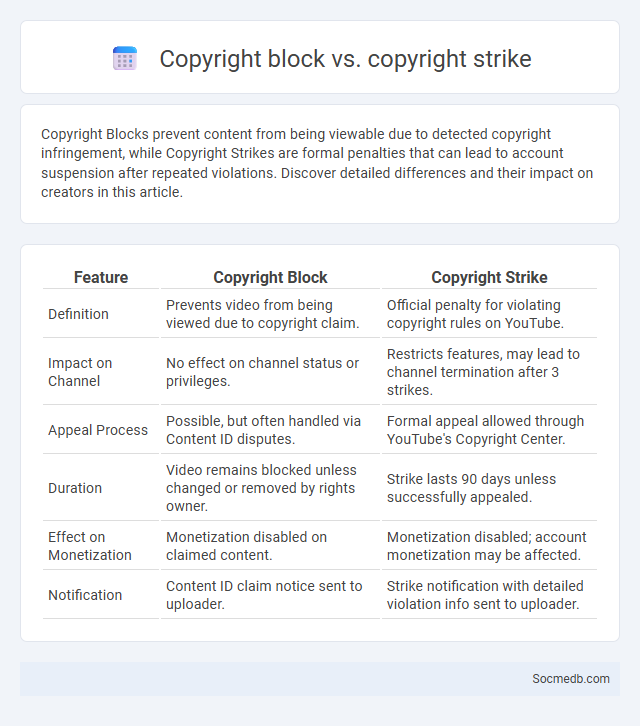
Photo illustration: Copyright Block vs Copyright Strike
Copyright Blocks prevent content from being viewable due to detected copyright infringement, while Copyright Strikes are formal penalties that can lead to account suspension after repeated violations. Discover detailed differences and their impact on creators in this article.
Table of Comparison
| Feature | Copyright Block | Copyright Strike |
|---|---|---|
| Definition | Prevents video from being viewed due to copyright claim. | Official penalty for violating copyright rules on YouTube. |
| Impact on Channel | No effect on channel status or privileges. | Restricts features, may lead to channel termination after 3 strikes. |
| Appeal Process | Possible, but often handled via Content ID disputes. | Formal appeal allowed through YouTube's Copyright Center. |
| Duration | Video remains blocked unless changed or removed by rights owner. | Strike lasts 90 days unless successfully appealed. |
| Effect on Monetization | Monetization disabled on claimed content. | Monetization disabled; account monetization may be affected. |
| Notification | Content ID claim notice sent to uploader. | Strike notification with detailed violation info sent to uploader. |
Introduction to Copyright Block and Copyright Strike
Copyright Block automatically prevents copyrighted content from being published or viewed on social media platforms, protecting intellectual property rights. Copyright Strike acts as a formal violation notice against users who repeatedly upload unauthorized copyrighted material, potentially resulting in account restrictions or termination. These mechanisms ensure compliance with copyright laws and safeguard creators' original works on social media channels.
Definition of Copyright Block
Copyright Block on social media refers to a tool or feature that detects and restricts unauthorized use of copyrighted content such as videos, music, or images. Social media platforms like YouTube and Facebook use automated copyright detection systems, often based on Content ID or fingerprinting technology, to identify and block content that infringes on intellectual property rights. This mechanism helps protect creators by preventing the distribution of copyrighted material without permission and managing rights holder claims efficiently.
Definition of Copyright Strike
A copyright strike is a formal notification issued on social media platforms when copyrighted content is used without permission, triggering content removal or account penalties. These strikes are part of copyright enforcement mechanisms to protect intellectual property rights and encourage responsible sharing. Accumulating multiple copyright strikes can lead to account suspension or termination under platform policies.
Key Differences: Copyright Block vs Copyright Strike
Copyright blocks immediately prevent your content from being viewed or shared due to detected copyright infringement, whereas a copyright strike is a formal warning that may lead to penalties like account suspension if repeated. You should understand that a strike impacts your channel's reputation and access to monetization, while a block only restricts content visibility without directly affecting your account status. Managing these distinctions effectively helps secure your digital presence and avoid long-term consequences on social media platforms.
How Copyright Block Works
Copyright block on social media platforms operates by using automated content recognition systems to detect copyrighted material in your posts. When the system identifies protected content, it can restrict access, mute audio, or remove the post entirely to prevent unauthorized use. Understanding these mechanisms helps you navigate content sharing responsibly and avoid potential copyright violations.
How Copyright Strike Works
Copyright strikes occur when you upload content that infringes on someone else's copyrighted material, resulting in a formal complaint from the rights holder. Platforms like YouTube use automated systems and user reports to detect unauthorized use, which can lead to content removal, account penalties, or loss of monetization. Understanding how copyright strikes work helps you protect your channel and avoid disruptions by ensuring all content complies with copyright laws and platform policies.
Impacts on Content Creators: Block vs Strike
Content creators face significant challenges from social media platform policies, where a strike can suspend features or monetize restrictions, while a block may remove access or prevent content visibility entirely. Your channel's growth and revenue can be severely affected by strikes, which often serve as warnings, whereas blocks can lead to permanent account restrictions or content removal. Understanding these distinctions helps creators navigate platform rules and protect their digital presence effectively.
Consequences of Multiple Copyright Strikes
Multiple copyright strikes on social media platforms can lead to severe restrictions on your account, including temporary suspensions or permanent bans, reducing your ability to share content and engage with your audience. These strikes often result in the removal of videos, images, or posts, causing significant disruptions to your online presence and growth. Repeated infringements may also limit your access to monetization features, impacting your revenue streams and brand partnerships.
Preventing Copyright Issues on Digital Platforms
Implementing robust content identification technologies and educating users about copyright laws significantly reduces violations on social media platforms. Platforms like YouTube utilize automated tools such as Content ID to detect and manage copyrighted material efficiently. Encouraging creators to use original or properly licensed content helps prevent legal disputes and fosters a compliant digital environment.
Legal Remedies and Resolution Options
Legal remedies and resolution options for social media disputes include cease and desist orders to halt defamatory content and litigation for intellectual property infringement or privacy violations. Alternative dispute resolution methods such as mediation and arbitration provide faster, less costly solutions for conflicts involving content ownership or platform policies. Enforcement of terms of service and collaboration with regulatory bodies also support resolving violations and protecting user rights on social media platforms.
 socmedb.com
socmedb.com